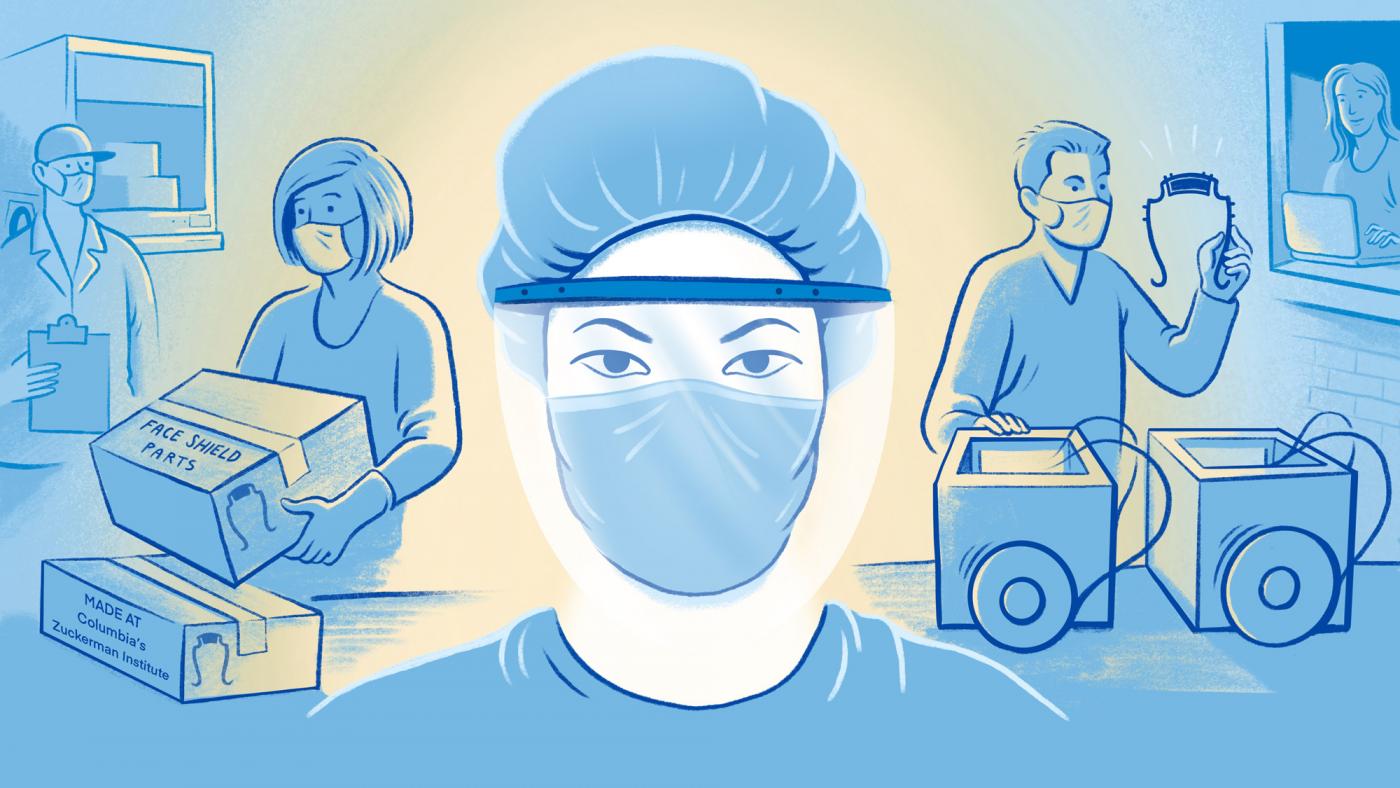KATHLEEN DURKIN Welcome to Lab in the Time of Coronavirus. I’m Kathleen Durkin of Columbia University’s Zuckerman Institute.
DEVIN POWELL And I’m Devin Powell of the Zuckerman Institute. This podcast is going to explore the daily lives of researchers at our brain science institute who are launching new efforts to combat COVID-19.
KATHLEEN You may have heard that science is shutting down. Labs across the country are closing their doors because of coronavirus.
DEVIN But there are people at our institute who are hard at work. Researchers who normally spend their time studying the brain are pivoting to combat coronavirus.
KATHLEEN Like me. I normally manage magnetic resonance imaging projects that scan the brain and the body.
DEVIN And I normally make videos about brain science as part of the communications team.
KATHLEEN But now we’re also creating this podcast.
DEVIN Today’s episode will focus on young researchers who have launched a new project to create protective equipment for healthcare workers out in the field. Our first episode explores how these researchers went from studying the brain to setting up a small-scale factory in only 48 hours.
KATHLEEN We talked to PhD candidate Leslie Sibener, who usually studies how the brain controls movements -- work that could help us understand movement disorders, like Parkinson’s.
LESLIE SIBENER I am in my fourth year of my PhD in Rui Costa’s lab, and I study motor learning, so basically that’s how you’re able to learn skilled movements, like learning how to serve a tennis ball.
KATHLEEN When her lab ramped down a couple of weeks ago, she started spending her time obsessively checking the news, until she found a better outlet for her energy and talents.
LESLIE There was about a week and a half after I had stopped going into lab where I wasn’t doing much of anything. And what was really great is that I started seeing this surge of activity within the Columbia community. So at the medical campus, there’s this group that’s called the Columbia Researchers Against COVID-19 (CRAC). There’s so many projects and so many people are working together at Columbia and even on a smaller scale even within the Zuckerman Institute itself. The main project that I’m in charge of is manning the 3D-printing farm that we have set up on the first floor of the Zuckerman Institute.
RACHEL CLARY So I’m sitting in the 3D-print farm. It’s a very ghost town feel here.
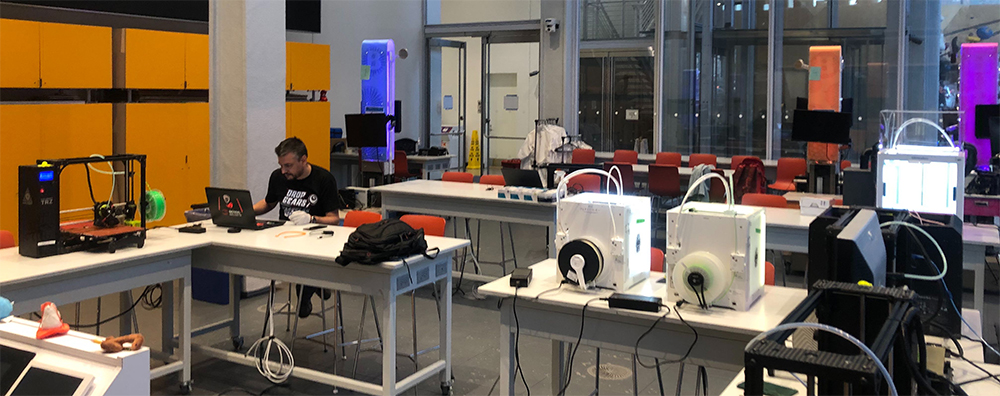
3D Print Farm in the Zuckerman Institute's Education Lab. Photo by Leslie Sibener.
KATHLEEN Rachel Clary, is a member of Ellen Lumpkin’s lab, currently working with the Zuckerman Institute’s Wes Grueber, PhD. She’s talking to us from a giant glass room on the first floor of the Zuckerman Institute. It’s the Ed Lab, or Education Lab, and usually it’s a really busy space. This is where we hold public programs about brain science for kids and students and for the local community.
DEVIN But today that giant glass room feels much emptier. It’s just one person surrounded by a host of 3D printers. These machines are spitting out plastic to build 3D objects, layer by layer.
RACHEL We have 10 printers, and they all have a nozzle from the top. There’s a little platform jiggling around, and then the nozzle also moves to shape the print. So it starts from nothing and then gets built up. So I can see right now that all of the printers are jiggling except for one just finished, so I’ll scrape it once we get off the call. It’s probably between 10 and 12 hours of active printing per day right now.
KATHLEEN All this activity allows the 3D-printing farm to make regular deliveries of personal protective equipment, or PPE, to healthcare workers in New York. Leslie continues:
LESLIE SIBENER We’ve partnered with an incredible grassroots organization, called NYC Makes PPE, to 3D print various items to serve to medical professionals and other underserved organizations in this crisis. One of the worst things that’s happening inside of hospitals right now is that they are running out of personal protective equipment, or PPE. These are things like face masks, and those can be the fancy N95 ones or just regular surgical masks. But it’s also things like goggles or face shields or clean gowns to put over their normal scrubs. We are just in incredible short supply. So the actual physical pieces that we’re producing right now are part of a face shield. And so that’s different than a face mask. A shield is exactly what it sounds like, this piece of plastic in front of your face to protect you from any sort of splatter, which you can imagine in a hospital room could be very messy.
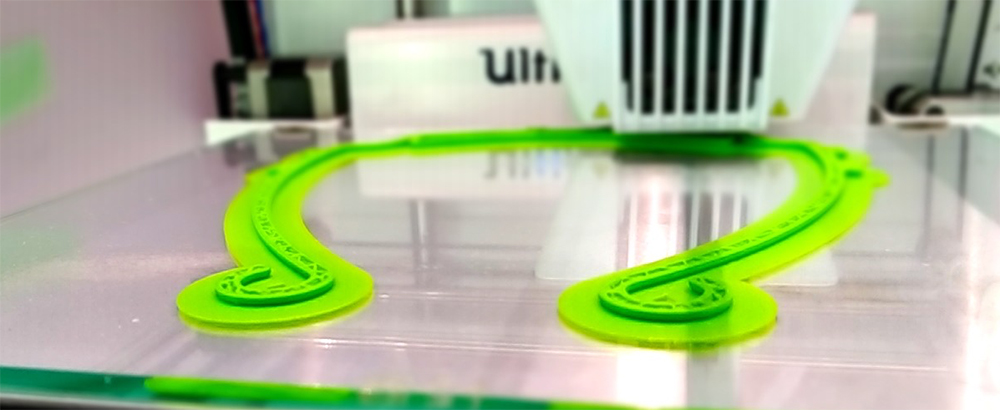
Face shield headband created by a 3D printer. Photo by Leslie Sibener.
RACHEL We have practitioners who are wearing one mask all day, despite whatever materials might encounter those masks, which includes a lot of liquids. Just having the shield itself will prevent a lot of splatter, and also just reduce the load on that one mask that these practitioners get to use per day.
DEVIN Making headbands for face shields isn’t how Rachel used to spend her time as a PhD candidate. But she believes that her scientific training helps.
RACHEL I normally study touch-sensitive neurons in the skin and especially how they maintain their architecture over time. As much as I’m not a doctor I still got into research to help humans. Many of my friends from grad school have been MD-PhDs. Thinking about them especially, some of my closest friends who are going to potentially be there on the front line without protective equipment really gives me a little bit more fire to try and find some way to help. And it’s made me feel just a little bit better that I’m not just staring at my computer pretending to work all day, while I am inside freaking out about what’s happening.
DEVIN The 3D-Print Farm started with students and engineers at the Zuckerman Institute emailing and calling each other and organizing online. From there, it really took off. Leslie told us this origin story.
LESLIE Rick Warren, my peer in my PhD program, he and Tanya Tabachnik, the head of the instrumental core, they started thinking about all these 3D printers that were in the Institute and what we could do with them. I had this first call with Rick and the next 48 hours was this whirlwind of grabbing printers and bringing them downstairs and getting everything set.
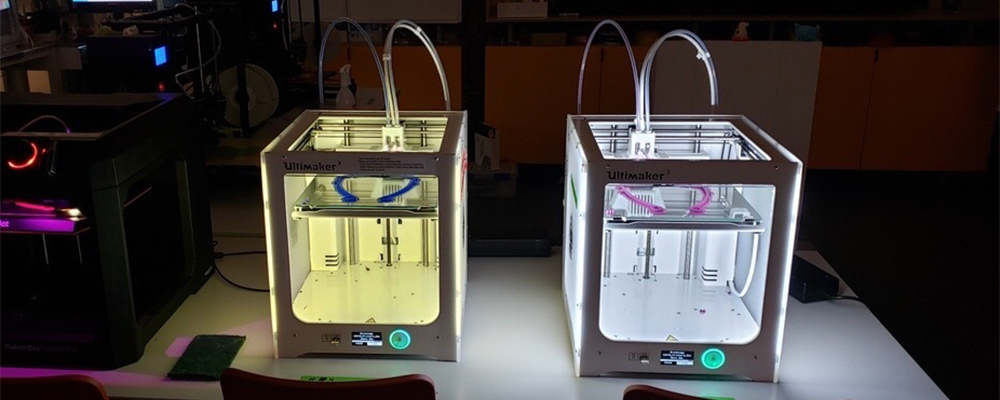
A pair of 3D printers in the 3D-Print Farm. Photo by Leslie Sibener.
RACHEL We have one from the Sawtell lab, two from the Axel lab, one from the Costa lab, or maybe even two. I think there’s one that lives here in the Education Lab.
LESLIE What’s fun about moving 10 different 3D printers into one space and trying to produce the same item is that each printer has their own little idiosyncratic issues. We had to troubleshoot each one individually.
RACHEL This is the first week that we’ve been doing this, so we’re figuring it out still. I was the first one that Leslie trained, so it was an experience for both of us to figure out how to train over Zoom. She had not yet found things like the file names that we were supposed to be printing. So I just had to try one. It turned out to be the wrong one and I have a pretty funny picture of basically a half like molten face visor, because one, yeah, the right side just – I don’t know why it messed up but it did, so just as a completely garbled mess.
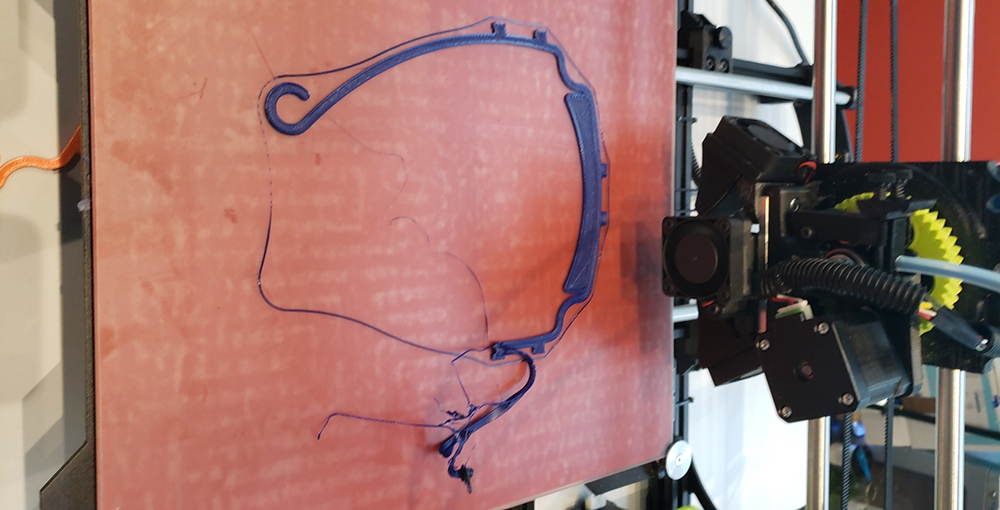
Face shield headband fail. Photo by Rachel Clary.
LESLIE The call for volunteers for the 3D farm was really spectacular. They just rose to the occasion. And I’m not surprised. I have had so many amazing collaborations scientifically with people in the building that I knew that people would be really eager to be a part of something like this as well. We actually had more volunteers than we needed, because another thing that we were trying to balance is not having that many people in the space. We have many rules for when you are in the 3D-print farm, but one of them is that only one person is allowed in there at a time We wanted to find the sweet spot of being as productive as possible but also making sure that we’re not increasing the risk for any one person who’s volunteering their time and willing to leave the comfort of home right now and feels okay walking outside and going into this space.
EILEEN HARTNETT I just press print and then wait and hang out and get to enjoy the benefit of being back in this beautiful space again.
KATHLEEN Eileen Hartnett is the latest addition to the team. She manages the lab of Daphna Shohamy, PhD, a scientist who studies memory, learning and decision-making.
EILEEN I normally work on fMRI studies of food choice behavior in patients with anorexia nervosa. When this email came out that we could help with making face shield parts, I thought great, that’s something that we can do, there’s so much we can’t control but there’s this one small thing we can. I hope that this is helping people, I really do, but also selfishly it definitely helped me to be part of something that’s hopefully making an impact in what’s going on right now. Like most people I miss my family. We don’t know when we can all see each other again. But I miss the lab family too and that environment. And honestly, just returning to the building was very calming. It was a nice relief to be there.
Getting one piece of equipment out there and having it be on the face of one doctor could potentially be the difference between them becoming infected or not. And that is something that I think is just really, really gratifying right now.” —Leslie Sibener, PhD candidate, Costa lab, Columbia’s Zuckerman Institute
DEVIN We asked Rachel what she missed from her pre-pandemic life.
RACHEL I was a big fan of taking scenic routes to and from the Zuckerman Institute as part of my daily exercise routine. So you know, a nice long walk along the river. It is nice to leave my apartment a couple of days per week and come here and still be technically isolating. We’re all feeling a drive to try and help right now, probably partially because we are affiliated with a hospital, so we are getting more peeks behind the screen of what it’s really like than the average citizen. I just encourage the community to think about other things that they could do like this that might seem really minor. But at this point we’ve probably printed 300 face [shield] parts in just a week so that’s 300 people that we’re helping.
KATHLEEN For Leslie, the project is unlike anything she’s experienced before. Even the way she thinks about time has changed.
LESLIE Now I definitely feel a lot more pressure in a way that is really different than anything I’ve experienced. The nature of doing a PhD is the exact opposite of what I’m doing right now. The PhD it’s this long journey where you decide to commit yourself for six years to one project. I’ve never had to deal with such a high-impact, short-term project. What we’re producing is going to be in use hours after it leaves our hands. Getting one thing out there and having it be on the face of one doctor, that could potentially be the difference between them becoming infected or not. That is something that I think is just really, really gratifying right now.
KATHLEEN Thanks for listening to Lab in the Time of Coronavirus. Take a look at the show notes for links to all the things we discussed. You can find all of our episodes at https://zuckermaninstitute.columbia.edu or on iTunes. Take a moment to rate and review us on iTunes. That makes it easier for other people to find us.
DEVIN Special thanks to Rui Costa, Jennifer Farris, the scientists who sat down with us for this episode, and the entire Zuckerman team. The music was provided by Miguel Zenón, Jazz Artist-in-Residence at the Zuckerman Institute. If you have thoughts or questions, you can find us on Twitter and Instagram @ZuckermanBrain. Our DMs are open! But before we go, Kathleen I think you had one last question for our researchers today.
KATHLEEN What is the first thing you plan to do, post-pandemic?
EILEEN See everyone that I missed. Stop social distancing. Give everyone a hug.
RACHEL Two of my classmates defended their theses at the very beginning of our ramp down period. So we had Zoom parties for them but it also does not feel like enough, especially for people who are moving onto their next chapter. So I’m really looking forward to a big rowdy park picnic celebrating my friends’ achievements after this is all over.
LESLIE Before everything started I had a very lovely monthly dinner with a group of my closest six friends plus or minus a few guests, and we would all crowd into one person’s apartment to cook dinner. And I would really love to be able to do that with them again sometime soon.
Note that some portions of this transcript have been ediited for clarity.
